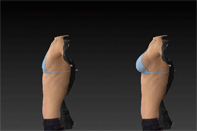Plastic surgery treatments such as Botox, fillers, and other non-invasive procedures have experienced a massive surge in popularity over the past 10 or so years. After all, who wants to undergo the knife and long recovery process when you can get work done via injection or other non-surgical methods?
Medical science is at the forefront of new discoveries that do just that – prevent the need to undergo plastic surgery. Coolsculpting is one of those revolutionary new treatments.
Developed around 2007 and given FDA clearance in 2010, Coolsculpting uses cold temperatures to freeze the fat on certain parts of the body. Over the course of a few weeks to a month or two, the human body will absorb the fat harmlessly.
We’re going to look at what Coolsculpting is, how it works, and whether it’s right for you.
How Does Coolsculpting Work?
Doctors noticed the science behind Coolsculpting for many decades before its invention. Doctors would see that children who ate a lot of popsicles seemed to have a fat reduction in their cheek areas. They called this phenomenon cryolipolysis, or the freezing of fat cells.
Coolsculpting is a non-invasive medical device that uses rounded paddles to suction up a small portion of your skin and fat. No incisions are made, just a gentle vacuum-like suction device that sucks up a tiny bit of skin and fat in between the paddles – almost as if you were gently pinching it yourself.
To perform the procedure, the patient is seated in a reclined comfortable chair for around 2 hours. The area that is to be treated is then cooled to a temperature that’s slightly below freezing. The cold is enough to kill fat cells, but it doesn’t kill other cells or cause permanent damage.
Most people who undergo Coolsculpting find that there is a very mild and tolerable discomfort as the procedure begins. After a few minutes, the area being treated goes numb, and patients can’t feel a thing. Many people who get the procedure done bring a laptop or their cell phone to work or chat with friends during the 2-hour treatment session.
Science Behind Freezing Fat
Coolsculpting has been looked at from a scientific perspective and found to be a safe method for body contouring. The science behind it is relatively simple and straight-forward. The Coolsculpting process uses a wand that applies cool temperatures to freeze fat cells. After a while, the human body will naturally absorb fat cells through normal metabolic processes.
The temperatures used in Coolsculpting are cold enough to freeze fat, but warm enough to not harm other cells or nearby body parts. This makes Coolsculpting such an ideal method to spot-treat areas of fat that exercise and diet have a hard time reducing. While Coolsculpting can’t take the place of liposuction procedures, it can help sculpt the body and deal with hard-to-remove areas of body fat.
Side Effects and Recovery Time
Coolsculpting is a non-invasive procedure so there are no incisions, medication, anesthesia, or anything of the sort that could cause complications or an allergic reaction. However, some people have reported mild side effects such as:
- Skin redness
- Sensitivity
- Bruising
- Localized pain
- Swelling
These side effects usually subside within a few days to a week or two after the procedure. Further scientific studies regarding the safety of Coolsculpting have been performed and only found mild short-term effects.
How Much Does Coolsculpting Cost?
The total cost of a Coolsculpting procedure depends on how many treatments were given. Some patients will require more than one treatment session to deal with stubborn fat areas. This is completely normal. The sessions are scheduled out because the body needs time to remove the layer of fat that has died off.
The best way to find out what Coolsculpting costs is to make an appointment with a qualified plastic surgeon. They will sit down with you and listen to your concerns and answer any questions that you might have. They’ll then give you a reasonable estimate of cost at that point in time.
CoolSculpting vs. Liposuction
Coolsculpting is not a replacement for liposuction. It’s more to deal with “spot treatments” of fatty areas that diet and exercise cannot remove. Liposuction is still the best way to remove big areas of fat in the body.
A consultation with a plastic surgeon is the best way to determine if you’re a candidate for Coolsculpting or if liposuction would be better to achieve the results that you desire. Sometimes the surgeon might recommend a combination of both – Coolsculpting to remove up to 25% fat in the treatment area such as the neck, bra bulges, or love handles – and liposuction to deal with other areas where fat is more prominent.
Coolsculpting in Dallas
If you’d like to learn more about Coolsculpting or have any questions that weren’t answered in this blog post, give us a call at (214) 965-9885 or contact us via our website. Dr. Adams is one of the leading plastic surgeons in the country and can help you get rid of that annoying body fat and help you achieve your perfect look!















